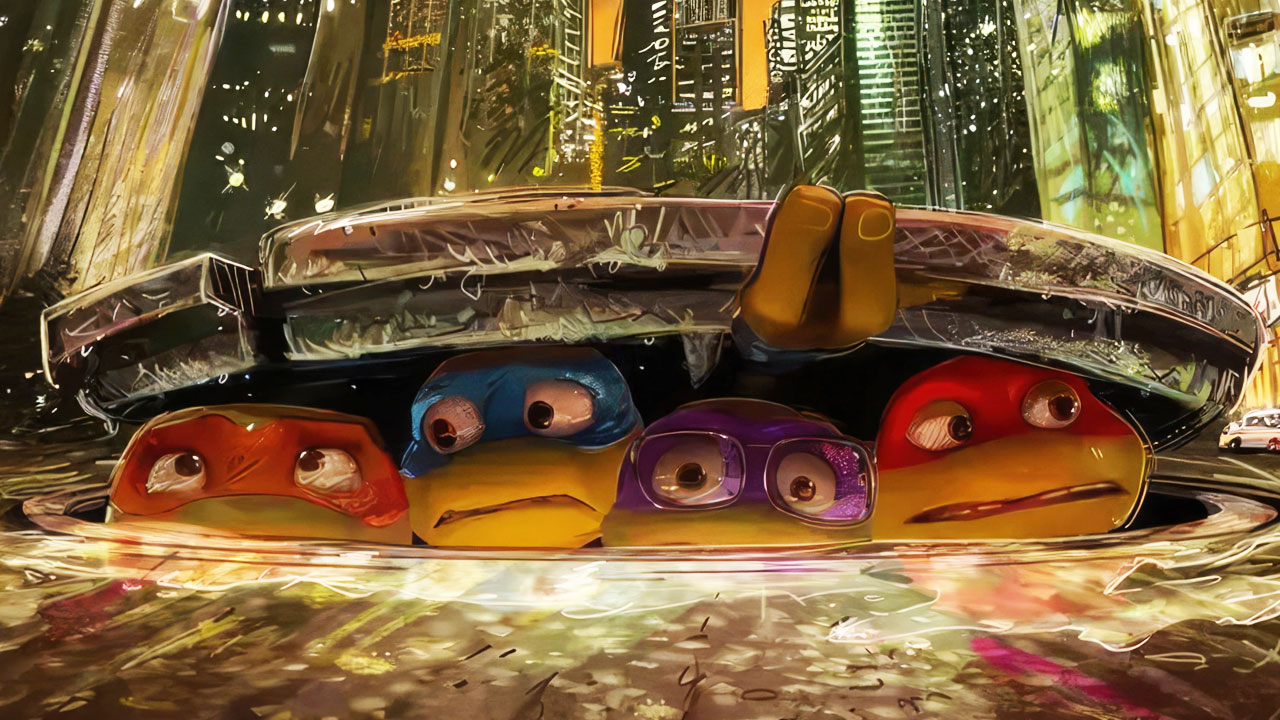The energetic Mutant Mayhem is let down by a same-old same-old storyline

A fresh coat of hand-drawn animation lives up the Teenage Mutant Ninja Turtles. To Luke Buckmaster, though, there’s not enough ingenious Mutant Mayhem in the new comedy’s screenplay.
Teenage Mutant Ninja Turtles: Mutant Mayhem
One way to come to terms with the enduring appeal of the Teenage Mutant Ninja Turtles is to view them as embodiments of being or feeling like an outsider—not dissimilar to the X-Men, or Paddington’s recent incarnations. But nobody wants to be that guy, scrounging for insight into the symbolism of anthropomorphized reptiles schooled in ninjutsu. Sometimes crazy crap just sticks to the zeitgeist. Bananas wear pajamas, there’s a sponge named Bob. The turtles’ seventh movie didn’t need to explain their origins—but who could resist a backstory involving radioactive ooze and a rodent sensei?
In Teenage Mutant Ninja Turtles: Mutant Mayhem, the pain and anguish of the turtles’ father figure, said sensei Splinter (voiced by Jackie Chan), is particularly pronounced. It ain’t easy being a rat. You’re born on the fringes and humans don’t like you. You can’t walk, only scurry—in this case, right into the bowels of New York’s sewer system, where Splinter discovered the only creatures who weren’t mean to him.
Splinter’s parenting of the titular characters embraced a two-pronged approach. One: train them to defend themselves. Two: do a King Triton and rant about bad things happening in the godforsaken world above. The turtles even recite a decree, rather pessimistic, beginning “humans are the demon scum of the earth” and concluding “to interact with them is to die.”
But it’s a fool who looks for logic in the chambers of the half-shell-covered heart. Not the first teenagers to long for acceptance, the ninja turtles—Donatello (voice of Micah Abbey), Michelangelo (Shamon Brown Jr.), Leonardo (Nicolas Cantu) and Raphael (Brady Noon)—decide to team up with April O’Neil (Ayo Edebiri) and fight the villain Superfly (Ice Cube) and his minions.
They hope society will embrace them, envisioning gratitude and high fives. There’s pathos, although Jeff Rowe’s mode is “fun” and “savvy,” moving on from the darker tone introduced in 2007’s TMNT. That savviness comes from Rowe understanding the shortcomings of previous instalments and making small but not insignificant changes. For instance the lead characters are now voiced by actual teenagers, god forbid, and the soundtrack is a banging compilation of 90s rap songs—drawing nostalgic vibes without making too much of it.
The direction is tight, as is the screenplay from Rowe and co-writers Seth Roger, Evan Goldberg, Dan Hernandez and Benji Samit. But their scripting is conventional and unimaginative, very same-old-same-old, conferred with an assumption that viewers will be happy to absorb bland regurgitated plotlines if the pace is peppy and the packaging snazzy. How many movie showdowns involve a Godzilla-like kaiju rampaging through city streets? Do writers blush when they suggest rolling out another jaywalking beast? It’s hard to stage something like that and bring any kind of narrative flair.

Consult Hellboy: The Golden Army for a notable exception. There’s a scene in which the hero is informed that a huge, plant-like, mayhem-creating monster is “the last of its kind” and if destroyed “the world will never see its life again.” Nevertheless, Hellboy slays it and this strange gargantuan thing turns into a brilliant blooming flower, making a point about how beautiful things can come from awful places. People won’t go into Mutant Mayhem expecting that kind of sentiment, but they didn’t expect it in The Golden Army either. The modus operandi should be: get ‘em in the door with the promise of spectacle, then deliver something unexpected.
The hand drawn look of Mutant Mayhem is its best feature, lovely and glob-like, dribbling colour and oozing textures—as if the entire film is caught in that instant when yet-to-dry paint hits the canvas. I dig its bold look and wished some of that boldness was brought to the writer’s room. The film feels too polished, too calibrated, too arranged. Rowe is more interested in learning from his predecessors than shooting for the stars. The recent and far superior Spider-Verse films do a better job integrating a fastidiously showy aesthetic, because they brought fresh ideas—like characters from parallel worlds who carry the visual form and structure of these worlds with them.
Early in Mutant Mayhem, the turtles surreptitiously attend an outdoor screening of Ferris Bueller’s Day Off, watching from a nearby rooftop. The film plays in its existing format, i.e. with human actors, which doesn’t make sense—bringing live action to an animated reality. But kids don’t care about that sort of thing these days. Contemporary pop culture is pastiche, melange, an infinite cycle, a blender without a lid.
Nothing is made of that Bueller moment and it lingers teasingly in my memory. Mutant Mayhem could’ve jumped into alternate realities, tripped the light fantastic, activated the holodeck, tried something different. Instead it’s just anther Ninja Turtles movie, savvier than the other ones.




















